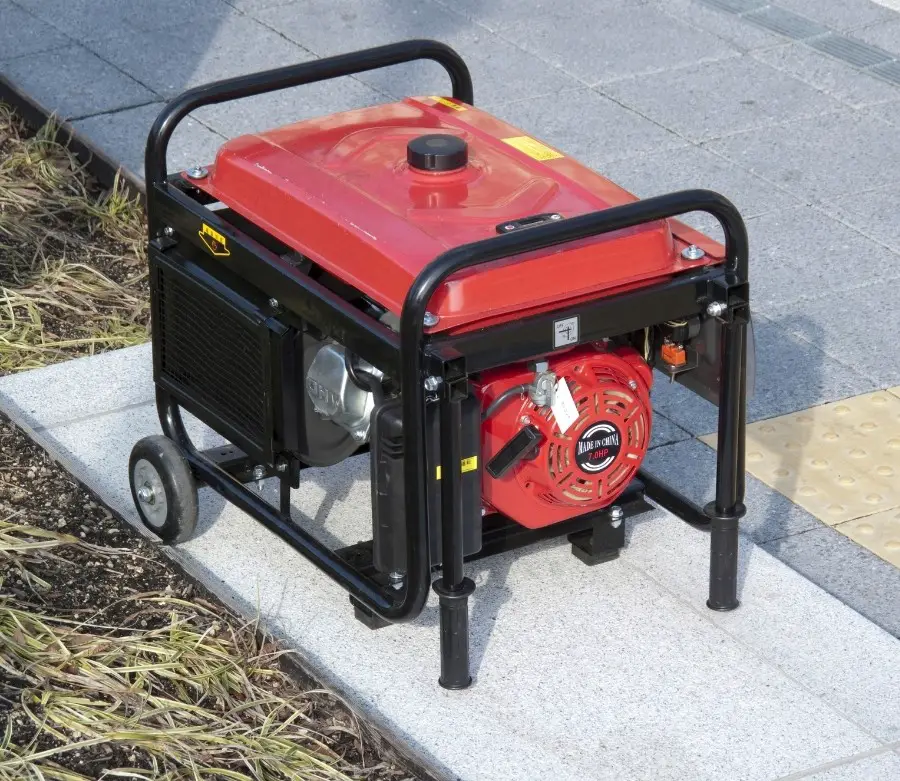
Portable generators can be vital tools for a variety of situations, and making sure your portable generator is grounded is essential to using it safely. In the event of a malfunction, having your generator grounded can prevent electrocution and fires.
Ground your portable generator in 3 easy steps:
- Hammer the copper rod into the ground; 8 feet minimum depth.
- Secure the copper wire to the grounding copper rod.
- Connect the wire to the portable generator. Locate the grounding bolt and secure the other end of the wire to it.
While the steps may seem easy, understanding why you need to ground your generator, having the proper tools, and whether you even need to ground your generator can be complicated.
This article will go over all those details and leave you confident in the process of grounding your portable generator.
Purpose of Grounding a Generator
Using equipment can be dangerous and pose many risks. Using a portable generator can pose a particular risk of electrocution, as well as be a fire hazard.
When there is a malfunction, the electricity will take the path of least resistance, and if you have the generator grounded, that’s the path it will take.
If your portable generator is not grounded, this is where you can possibly be electrocuted as the electricity searches for the path of least resistance.
Likewise, other issues may occur, such as blowing a breaker if one is installed, as well as burning up fuses and wiring. Choosing not to ground your portable generator can be a fire hazard if a short circuit happens.
You want to always protect your tools and equipment. If a malfunction does happen and electricity goes haywire, items connected to your generator could get burned up and ruined.
Overall, the purpose of grounding your generator is safety, and when done properly should allow you to use your equipment without concern of electrocution or starting a fire.
Tools Needed To Ground a Portable Generator
If you are going to need to ground your portable generator yourself, and it doesn’t have the proper tools included, it can be a pain to figure out exactly what you need.
This section contains a list of some tools that are needed to properly ground your generator.
- Wire strippers are essential to strip the copper wire for the correct amount of insulation.
- Copper ground rod to drive into the ground and connect your generator so that any excess electricity is grounded.
- A tool for hammering the copper rod into the ground is needed. There are a few options here, including hammers, mallets, sledgehammers, and really anything you can use to drive the rod.
- Copper grounding wire with insulation so you can connect the copper rod to your generator. Make sure you get enough in case you need to replace the fraying wire or are not used to stripping wire.
- An adjustable wrench is necessary to loosen or tighten the grounding bolt on your generator. You’ll want to make sure you have the means to adjust this to properly fasten the copper ground wire to your portable generator.
- Pliers are useful for manipulating the copper wire and wrapping it as tightly as possible around the rod or ground bolt in order to reduce fray or any exposed wiring.
- Copper clamp (optional) can be useful to secure the wiring further to the copper rod.
How To Ground Your Portable Generator
As mentioned before, there are three easy steps to grounding your portable generator.
Those steps are broken down into more depth:
Hammer Copper Rod Into the Ground
This is not a step you should overthink. Make sure to hammer the copper rod into the ground a few feet, leaving some of the rod showing so that you still have room to wrap the copper wire around it.
Placing it at least 8 feet away from the generator is a good idea for safety.
Driving a long rod into the ground can be tough if the area is rocky, and there are some underground obstacles. You are allowed to angle the rod at a maximum of 45 degrees if needed.
Strip Wire and Secure To the Rod
The proper copper wire will be insulated, and the wire itself needs to be wrapped around the rod. Make sure first to measure how much exposed wire you will need to wrap around the rod properly.
Remember that you can always strip more wire, but you cannot put the insulation back on once stripped, so make sure not to over strip and leave exposed wire.
Once you have stripped the amount of wire necessary, wrap the wire around the rod with a pair of pliers and secure it so that it won’t slip or disconnect. A clamp can be a useful extra piece to tighten the wire to the rod.
Connect Wire To Generator
Once you have completed the first two steps, you should have a copper rod in the ground with your copper wiring wrapped securely around it. Now you will take the other end of the copper wiring and strip it similar to the first time.
The next step is to locate the grounding bolt on your portable generator. You will then secure the exposed wire to the bolt by wrapping it with pliers similar to attaching to the rod. You can then also use the bolt and fasten the wiring to the generator.
If you are more of a visual learner, the video below quickly shows you the process described above.
Do I Need To Ground My Portable Generator?
Grounding your generator is vital to operate it safely. All generators must be grounded in order to use safely and properly; however, the amount of action needed to take by yourself to ground it depends on the portable generator.
The first step you should always take is reading the owner manual, as usually it will indicate if any steps need to be taken. If your manual mentions that your generator uses a “separately derived system,” then this is an indicator you will need to ground your generator.
Most newer portable generators will not need grounding as their frame does that for them. Older generators are more likely to need to be grounded manually.
If you are missing your owner’s manual, there are other indications as to what to do. Find the transfer switch on the generator and if:
- Allows transfer to neutral conductor – does not need to be grounded.
- It does not allow transfer to neutral conductor – needs to be grounded.
If you are still unsure about what to do, then it would be best to contact the manufacturer of your generator directly and have them walk through anything you may not understand or be able to find.
In Conclusion
Since using equipment can be dangerous, minimizing the risk by grounding your portable generator may be necessary.
Taking steps to make sure you know whether you need to ground your generator is something you should learn right away when buying or using a new generator, by consulting the owner manual, or by locating the transfer switch on your generator.
Make sure to review the three easy steps of installing the copper rod and connecting it to the generator.
With those three easy steps and the proper tools such as your copper grounding rod, wire strippers, copper wire, and the other tools listed above, you will feel confident in grounding your portable generator properly.
Sources:
https://generatorgrid.com/blog/grounding/
https://generatoradvisor.com/ground-portable-generator/
https://www.rsandrews.com/blog/how-does-electrical-grounding-work/
https://www.osha.gov/OshDoc/data_Hurricane_Facts/grounding_port_generator.html







